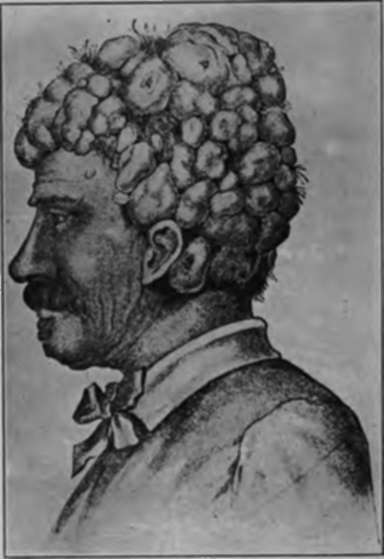Tumors of Scalp
Description
This section is from the book "Skin Cancer", by Henry H. Hazen, A.B., M.D.. Also available from Amazon: Skin Cancer.
Tumors of Scalp
The commonest new growths upon the scalp are of a benign variety; wens or warts are especially common. Malignant melanotic growths at times have their origin here. Cancer of the scalp is rather uncommon. According to Hertzler, von Bergmann found that out of 675 skin cancers in his clinic, 36 had their origin in the scalp. These tumors may be either basal-celled or prickle-celled, but the latter are probably the more common. Bloodgood states that out of 17 epithelial tumors, only 6 were basal-celled, and 2 of my own 3 cases were prickle-celled in character. In small basal-celled tumors, excision is the proper course, but in large neoplasms it is justifiable to try x-ray, because a plastic operation to repair the defect caused by extensive excision is very difficult. In the prickle-celled growths, broad local excision and removal of the neighboring glands is the best. Of course, in this location block dissection is impossible.
From time to time cases of malignant turban tumors have been reported. While these were given various names, and while the pathological examinations differed somewhat, still all of these growths had many clinical characteristics in common, and the name "endothelioma capitis" has been pretty generally applied. Ancell* recorded a case occurring in a 26-year old woman, and which was present for ten years. At autopsy metastases were found in the liver. Four relatives were similarly affected, but the disease remained local in all of them. Baker* reported another case in a man aged 24. Tumors developed shortly after traumatism, some of them underwent spontaneous involution, but one grew until it reached a diameter of 10 inches, when it was surgically removed and reported by the pathologist to be a fibrosarcoma. Cohn* reported an instance in a woman aged 52, who had the malady for twenty-six years. One of her children had the same trouble. The pathological diagnosis was "alveolar sarcoma of Billroth." Kaposi* reported a ease in a man aged 60, who had been affected for forty years, and whose daughter had a similar condition. Oro* saw a ease which developed after injury, and which was thought to be a spindle-celled sarcoma. Barrett* saw the same condition in a mother and her two daughters. He called the growths "multiple sudoriperous adenomata." Spieg-ler* has carefully studied the condition and decided that the condition was really endothelfomatous. Poneet* has described another ease, calling it a cylindroma of the sebaceous glands. Haslund* reported a ease in which metastases occurred. Hoffmann and Friboes* mention still other cases. Lawrence has seen the disease in a mother and daughter, and the pathological report was endothelioma.
*Hertzler: Treatise on Tumors, New York, 1912.
*Ancell: Quoted by Hoffmann and Friboes.
*Baker: Quoted by Crocker, Diseases of the Skin.

Fig. 71.-Endothelioma capitis. (After Spiegler).
*Cohn: Jour. Cutan. and Genito-Urinary Dis., 1892. x. 393. •Kaposi: Comptes Rendus de Cong. Internat., Rome, 1894, 135. *Oro: Giono. Hal. d. mal. Ven. e. d. Pelle, 189C, Fass. ii. 'Barrett: Brit. Jour. Dermat., Feb. 6, 1832. •Splegler: Arch. f. Dermat. u Syphil.. 1899, 1. 163.
Hoffmann and Friboes have described a ease which they consider to be a perfect illustration of a benign basal-celled tumor. They are inclined to believe that the vast majority of these growths are basal-celled in character. Krompecher* agrees in this view. It is probable that various types of malignant growth can give a similar clinical picture, .and that treatment must depend entirely on the microscopical findings.
Continue to:
- prev: Chapter XIX. Tumors According To Location
- Table of Contents
- next: Tumors of Forehead And Temples
Tags
bookdome.com, books, online, free, old, antique, new, read, browse, download
